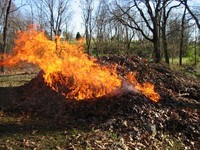October 17, 2005
Up In Smoke: The Bonfire Of The Inanities
By Michael D. Shaw
Along with Autumn’s brilliant colors comes something close to mass hysteria. Reasonable concern about the practice of burning leaves seems to have given way to warnings about death, injury, and permanent respiratory ailments, stemming from this ancient practice. Welcome to this season’s brand of paranoia.
Though many municipalities ban the activity, owing to legitimate air pollution issues, such as the famed inversion layer of the Los Angeles basin, leaf burning is not anywhere near as dangerous or calamitous as its opponents claim. The rush to outlaw leaf burning is, like similar attempts to virtually criminalize tobacco or misinform citizens about the effects of secondhand smoke, nothing more than the politicization of science.
No doubt, responsible individuals are fully capable of using leaf burning in a controlled, effective, and safe manner. Fears about long-term health implications, asthma, and wild fires are largely just that: fears, a crippling sense of dread and shouting.
To be fair, it is unwise for certain people to use leaf burning as a means of yard cleaning or waste disposal. Why? Because leaf burning can irritate the eyes, nose, and throat; it can also be harmful for individuals with respiratory or heart problems. As such, those with preexisting health conditions, including asthma, emphysema, or cardiovascular problems, should avoid the practice.
That being said, citing the potential hazards to such folks as proof that leaf burning is GENERALLY dangerous, is akin to claiming that sugar is harmful to the population at large because it can be deadly to diabetics. One could list many common household items that pose a far greater potential threat than the fumes of burning leaves.
Yet, there are those who would magnify the perils of leaf smoke. Consider this attempt at crying wolf from the state of Wisconsin, in its pamphlet about the health effects of leaf burning:
“Leaf smoke contains many hazardous chemicals, including carbon monoxide and benzo(a)pyrene. Carbon monoxide binds with hemoglobin in the bloodstream and thus reduces the amount of oxygen in the blood and lungs. Carbon monoxide can be very dangerous for young children with immature lungs, smokers, the elderly, and people with chronic heart or lung diseases.”
While all this is true, it is extremely misleading. Unless the leaves are burned indoors, there is simply no way that anyone but the most sensitive individual could suffer ill effects from a few whiffs of an Autumn bonfire. In fact, a recent query on Google about the number of deaths from leaf burning and carbon monoxide gas turned up a grand total of zero fatalities.
Even worse is the attempt to frighten people by linking leaf burning with benzo(a)pyrene, a carcinogen in animals, and a major factor in smoking-induced lung cancer. To make this connection is to ignore the most important adage in toxicology: The dose makes the poison.
In other words, trace amounts of benzo(a)pyrene or infrequent burning of leaves hardly amounts to either an environmental hazard or a cancer threat. The real danger is from politicians and interest groups that seek to conflate a relatively harmless practice (leaf burning) with a highly destructive enemy (cancer).
Leaf burning is an old and, until recently, common practice. It demands safety, responsibility, and clear guidelines, as do countless other tasks. It does not need, and we should not quietly accept, its wholesale criminalization. People are not dying en masse from leaf burning, and they never did. Let’s approach this issue with the sweet light of reason.

